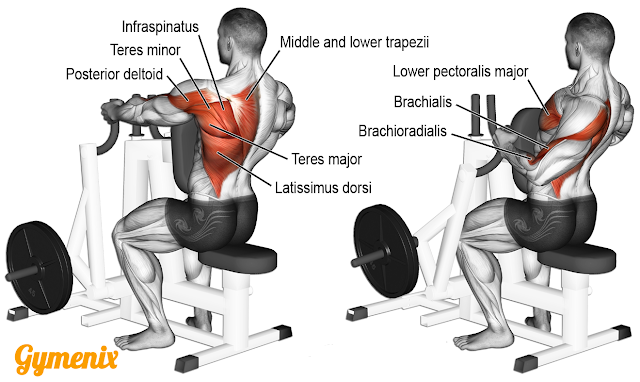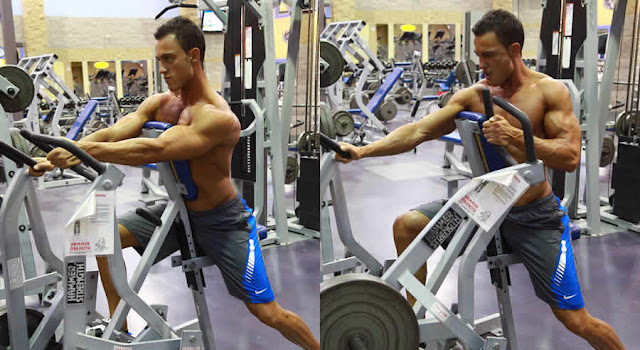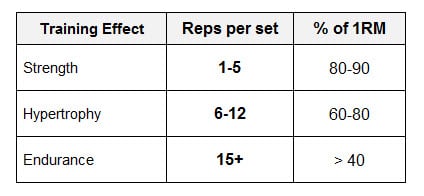Hammer Strength Rows - What Are They & How Do I Do Them?
What are Hammer Strength Rows?
Hammer strength rows are a resistance exercise performed on a hammer strength row machine in a gym. The target muscles for this exercise are the Latissimus Dorsi muscles in the mid-back. These are the muscles that give your back thickness and width.
The exercise is similar to a cable row or a bent-over dumbbell row but is by using a plate loaded machine and a padded chest support, you are able to move much heavier loads. Your legs, lower back and core muscles are taken out of the movement meaning that you can isolate the lats for a better back workout.
How to do a hammer Strength Row
To perform a hammer strength row, you will need access to a hammer strength row machine. These are a fairly common sight in the majority of commercial gymnasiums.
The exercise is simple to perform. To get set up, you will firstly need to load your machine with weight plates to get the resistance for your back to work against. Start with a light resistance to warm up and pyramid up to your working sets.
- Sit on the machine with your sternum resting against the pad. Use the seat height adjustment so that the pad is not pressing into your stomach but is not too high up on your chest.
- Put one leg forward so that your back arches slightly. This goes against most exercise advice due to fear of pressure on the spine but for hammer strength rows, you will get much better lat activation with an arch.
- Keeping the upper body against the pad, row the handles back towards you until you feel the lats, traps and rear delts contracting.
- When fully contracted, hold the position for three seconds and squeeze the lats.
- Slowly return arms to the starting position in a controlled movement.
- At the end of each rep, use the weight of the bar to really stretch the lats for a second of two before starting the next rep.
- Repeat for the required number of reps and sets.
Tips for better results
Do not row with your arms. Keep them slightly bent throughout the movement but make sure that it is the muscles in your back doing the heavy lifting. If you can not feel a connection with these muscles, reduce the weight and place emphasis on form and time under tension.
When you row the handles towards you, keep your chest pressed against the pad so that your lower back is not assisting the lats.
Also, make sure that you return the bar between sets and stretch out the lats, do not allow the arms to fully stretch. Keep them slightly bent and extend your shoulders forwards to stretch the lats.
If you are going to train with a heavy load, consider using wrist straps to take the strain. This may help you to squeeze out those few extra reps and get the most from each set. Just make sure that you are using a loose enough wrap so that they will quickly unravel when you take your palms away from the handles.
The One-Arm Hammer Strength Row
If you really want to isolate the lats and feel the mind-muscle connection, consider working one side at a time on the hammer strength row machine. This is a great option if you wish to train with a lighter load and focus on the range of motion and time under tension.
Using one arm at a time allows you to twist the body slightly so that you are pulling the handle across the body as well as backwards. This hots the lats from a slightly different angle and allows a much bigger stretch at the top of the movement.
How to do Hammer Strength One-Arm Rows
- Load your weight plates and adjust the seat height so that you can rest your lower chest comfortably on the support. Make sure that you are able to row backwards and forwards in a level motion in order to activate the lats to the full extent. A good way to measure is to make sure that your forearms are parallel to the floor. Too high or too low will bring the bicep into play too much and put unnecessary pressure on the elbow joint.
- Twist slightly to the side, reach across your body and grab the handle of the machine.
- Keeping your arms slightly bent and elbow close to the body, breathe out and row the handle towards the body until the lat muscle is fully contracted.
- Hold this position for three seconds and squeeze the contracted muscle.
- Breathe in as you return the handle to the starting position.
- Stretch the lat at the start position by rotating the shoulder forwards slightly. Make sure the arm is still slightly bent throughout.
- Repeat for the required number of reps and sets alternating sides between each one.
Tips for a Better Hammer Strength One-Arm Rows
It is crucial to set the seat height to the right position to get the most from this exercise. Too high, and you are letting the rear delts do all of the work. Too low and the biceps will be taking the strain. Set to a height that allows your forearm to be parallel to the floor when gripping the handles.
Utilise the hand from the side that you are not working on to stabilise the body. You can grip the frame of the machine or the top of the chest pad. This will stop the body from twisting with the movement and allow you to focus on the target muscles.
Make sure that you breathe out as you exert the body and row the weight towards you and breathe in as you return to the starting position. This will help to harness power when you need it and keep your oxygen levels high.
It is important to hold the contraction and squeeze the muscle if you are aiming for hypertrophy. Using a lower weight with strict form, slow movement and squeezing the contraction will give optimal muscle growth.
If strength is your end game, you do not need to worry about squeezing the lats. This will allow you to train with much heavier loads for optimal strength gains.
How Many Reps When Performing Hammer Strength Rows
Rep range is going to differ depending on your experience and your goals. If you are an experienced lifter looking for strength gains, you can aim for 5 sets of 3-4 reps with a very heavy load. You will need to pyramid up to your working sets in order to avoid injury.
If hypertrophy is your goal or if you are a beginner, use a lighter weight and place focus on good form. Using a good form with a full range of motion and slow movement will put the muscle under tension for a longer time. Aim for 4 sets of 12-15 reps for maximum hypertrophy gains.
Common Mistakes When Performing Hammer Strength Rows
There are some common mistakes that people make with hammer strength rows:
- Not adjusting the seat. As mentioned previously, if your forearms are not parallel to the floor when gripping the handles, then you need to adjust the seat. The best case is that you will bring the rear delts and lats in to play too much and not get as much lat activation. The worse case is that you will cause injury by placing too much strain on the back muscles, spine and elbow joint.
- Train according to your goals. If you are training for hypertrophy or functional fitness, there is no need to go too heavy. Stick to a moderate load and focus on muscle connection, good form and time under tension. This will yield much better muscle growth results.
- Leaning back with each row is a common mistake you see with people using this machine. By doing this, you are activating the lower back for the first part of the movement and then the rear dels/biceps will take over. This means that you are not heavily activating the lats which is the main target area.
- Flaring elbows. this is a tricky one. If you want the lats to get the maximum benefit from the rows, you will need to keep your elbows tucked in. That being said, some experienced lifters will deliberately flare the elbows so that they can bring the rhomboids, lower traps and rear delts into play. This way they are getting more of a total aback workout.
When To Use Hammer Strength Rows
Hammer strength rows are best performed when you train the rest of your back. If your split involves full-body workouts, these are a great way to hit the mid-back and rear delts. If you follow a bro split, you can just throw them into your back day in the place of dumbbell rows or regular cable rows.
A good hypertrophy split will hit the lats at least twice a week. Check out our HyperGrowth bodybuilding program by clicking on the menu bar at the top of the page. It is a scientifically-backed way to maximise muscle growth through optimal training frequency. The program is 100% free and includes diet advice and supplement recommendations.
Alternatives to Hammer Strength Rows
There are a few other ways to hit the lats if you do not have a hammer strength row machine:
Cable rows are the obvious alternative to hammer strength rows as they allow you to isolate and activate the lats in the same way. The downside to using a cable row machine is that there is no chest support so your core muscles are engaged to keep your body rigid.
Bent over rows are a great way to add mass to the lats and the entire mid-back. As with hammer strength rows, you can go really heavy on this movement, especially if you have a power rack from which to lift. from. As with cable rows, there is no core support so your abs, lower back and legs all play a part in stabilising the body for the movement. This makes it harder to isolate and connect with the target muscle.
Dumbbell rows are a popular movement for lat development and a great alternative to the hammer strength row. As you are bent over and supported by a bench, you can isolate the lats in the same way. It is hard to go quite as heavy with dumbbells as it is with a machine.
Lat pulldowns are great for isolating the lats and adding width to them. Opt for a narrow grip with a v bar where possible as this will give you thickness as well as width. Recent studies have shown that there is no advantage to using a wide grip unless you want to add width without the thickness.
Lat pushdowns are probably the most underused and underrated exercise for developing the lats. They allow you to hit the lats from a different angle and force hypertrophy. Try adding them in at the end of a back day to really finish the lats off.
Conclusion
If you want to develop your lats, hammer strength rows are probably the best exercise to use in terms of both strength and hypertrophy. If you have one in your gym and are not using it, you are missing out on some serious gains.
We hope that you have found this article informative and that it has answered any questions that you may have had about the hammer strength row. Subscribe to our feed or follow us on social media for more exercise tips and free training programs. Remember they are all backed by science, proven and 100% free!
-min.png)




.png)

.png)



